1995 BUICK REGAL lights
[x] Cancel search: lightsPage 12 of 340
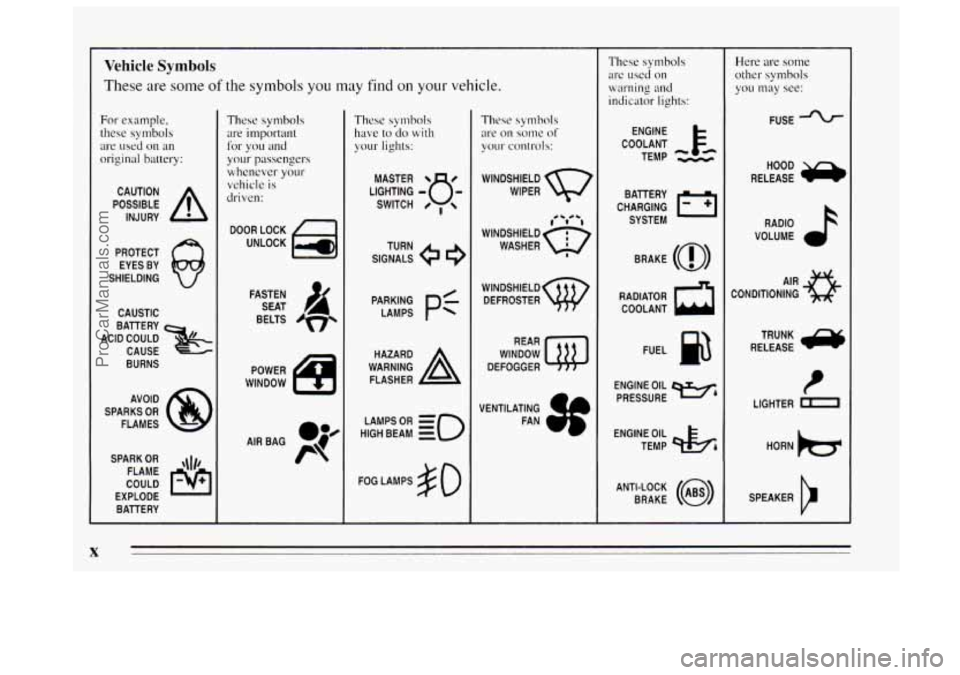
Vehicle Symbols
These are some of the symbols you may find on your vehicle.
For example,
these symbols
are used
on an
original battery:
POSSIBLE A
CAUTION
INJURY
PROTECT EYES BY
SHIELDING
CAUSTIC
BATTERY
CAUSE
BURNS
ACID COULD
x
AVOID
SPARKS
OR
FLAMES
SPARK
OR ,\I/,
COULD FLAME
EXPLODE BATTERY
These symbols are important
for you and
your passengers whenever your
vehicle
is
driven:
DOOR LOCK
UNLOCK
BELTS
4
These symbols
have
to do with
your lights:
SIGNALS e
TURN
POWER
WINDOW
HIGH LAMPSoR BEAM
= =o
FOG LAMPS $0
These symbols
are on
some of
your controls:
WINDSHIELD
WIPER
1. *td -1
WINDSHIELD c)
WASHER a
WINDSHIELD DEFROSTER
WINDOW
DEFOGGER
VENTILATING FAN
These symbols
are used on
warning and
indicator lights:
COOLANT F-
TEMP --
ENGINE
CHARGING BATTERY
SYSTEM
BRAKE
(0)
RADIATOR COOLANT
a
FUEL
ENGINE OIL
PRESSURE
w4
TEMP OIL 4%
ANTI-LOCK (@)
BRAKE
Here are some other symbols
you may
see:
FUSE
RADIO
VOLUME
AIR
CONDITIONING
TRUNK
e
RELEASE
t
LIGHTER n
SPEAKER
b
X
ProCarManuals.com
Page 73 of 340
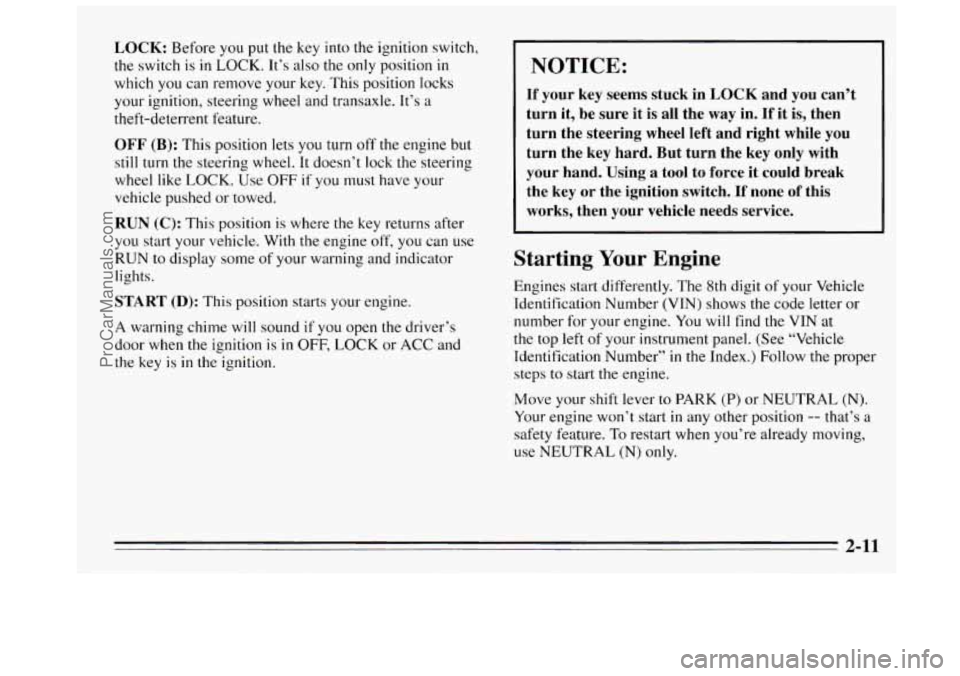
LOCK: Before you put the key into the ignition switch,
the switch is in
LOCK. It’s also the only position in
which you can remove your key. This position locks
your ignition, steering wheel and transaxle. It’s a
theft-deterrent feature.
OFF (B): This position lets you turn off the engine but
still turn the steering wheel. It doesn’t lock the steering
wheel
like LOCK. Use OFF if you must have your
vehicle pushed or towed.
RUN (C): This position is where the key returns after
you start your vehicle. With the engine off,
you can use
RUN to display some
of your warning and indicator
lights.
START (D): This position starts your engine.
A warning chime will sound if you open the driver’s
door when
the ignition is in OFF, LOCK or ACC and
the key is
in the ignition.
NOTICE:
If your key seems stuck in LOCK and you can’t
turn it, be sure it is all the
way in. If it is, then
turn the steering wheel left and right while you
turn the key hard. But turn the key only with
your hand. Using a tool to force it could break
the key or the ignition switch. If none of this
works, then your vehicle needs service.
Starting Your Engine
Engines start differently. The 8th digit of your Vehicle
Identification Number (VIN) shows the code letter
or
number for your engine. You will find the VIN at
the top
left of your instrument panel. (See “Vehicle
Identification Number” in
the Index.) Follow the proper
steps to start
the engine.
Move your shift lever
to PARK (P) or NEUTRAL (N).
Your engine won’t start
in any other position -- that’s a
safety feature. To restart when you’re already moving,
use NEUTRAL
(N) only.
2-11
ProCarManuals.com
Page 106 of 340

Warning Lights, Gages and
Indicators
This part describes the warning lights and gages that
may be on your vehicle. The pictures will help
you
locate them.
Warning lights and gages can signal that something
is
wrong before it becomes serious enough to cause an
expensive repair or replacement. Paying attention to
your warning lights and gages could also save
you or
others from injury.
Warning lights come on when there may be or is a
problem with one of your vehicle’s functions. As
you
will see in the details on the next few pages, some
warning lights come
on briefly when you start the
engine just to let
you know they’re working. If you are
familiar with this section, you should
not be alarmed
when this happens.
Gages can indicate when there may be or is
a problem
with one of your vehicle’s functions. Often gages and
warning lights work together to let you know when
there’s a problem with your vehicle. When
one
of the warning lights comes on and stays on
when you are driving, or when one of the gages shows
there may be a problem, check the section that tells
you
what to do about it. Please follow this manual’s advice.
Waiting
to do repairs can be costly -- and even
dangerous.
So please get to know your warning lights
and gages. They’re
a big help.
Fuel Gage
I UNLEADED FUEL ONLY
I
Your fuel gage tells you
about how much fuel you
have left when the ignition
is on. When the indicator
nears
EMPTY (E), you still
have a little fuel left, but
you should get more soon.
Here are some things owners ask about. All these
situations are normal and do not show
a problem with
your fuel gage:
0 At the service station, the pump shuts off before the
gage reads
FULL (F).
2-44
ProCarManuals.com
Page 150 of 340
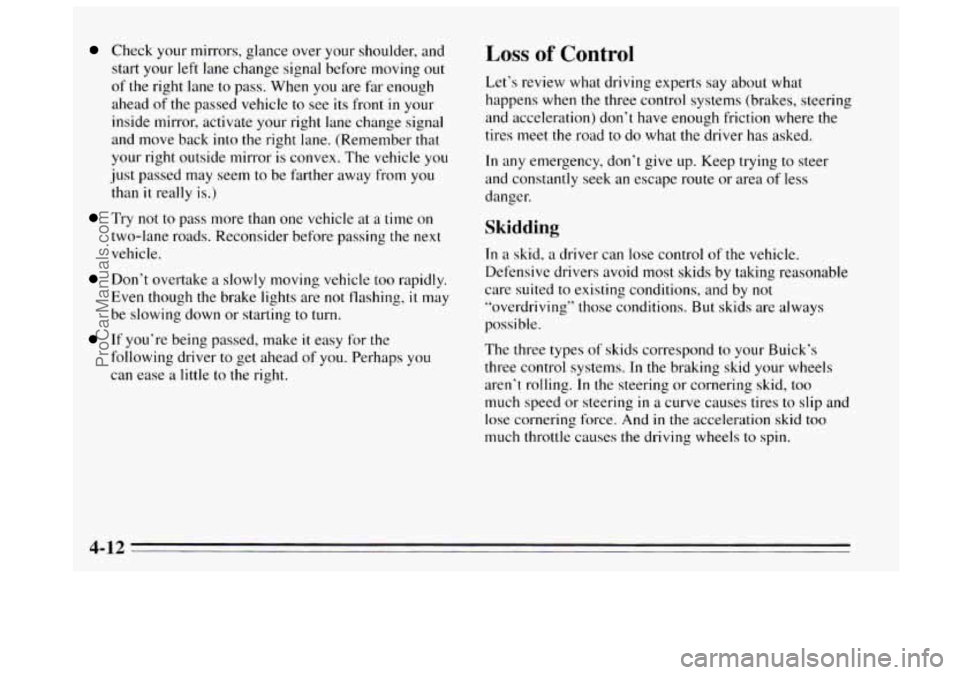
Check your mirrors, glance over your shoulder, and
start your left lane change signal before moving out
of the right lane to pass. When you are far enough
ahead
of the passed vehicle to see its front in your
inside mirror, activate your right lane change signal
and move back
into the right lane. (Remember that
your right outside mirror is convex. The vehicle you
just passed may seem
to be farther away from you
than it really is.)
Try not to pass more than one vehicle at a time on
two-lane roads. Reconsider before passing the next
vehicle.
Don’t overtake a slowly moving vehicle too rapidly.
Even though the brake lights are
not flashing, it may
be slowing down or starting to turn.
If you’re being passed, make it easy for the
following driver
to get ahead of you. Perhaps you
can ease
a little to the right.
Loss of Control
Let’s review what driving experts say about what
happens when the three control systems (brakes, steering
and acceleration) don’t have enough friction where the
tires meet the road
to do what the driver has asked.
In any emergency, don’t give up. Keep trying to steer
and constantly seek an escape route or area
of less
danger.
Skidding
In a skid, a driver can lose control of the vehicle.
Defensive drivers avoid most skids by taking reasonable
care suited to existing conditions, and by not
“overdriving” those conditions.
But skids are always
possible.
The three
types of skids correspond to your Buick’s
three control systems. In the braking skid your wheels
aren’t rolling. In the steering or cornering skid,
too
much speed or steering in a curve causes tires to slip and
lose cornering force. And
in the acceleration skid too
much throttle causes the driving wheels to spin.
4-12
ProCarManuals.com
Page 152 of 340
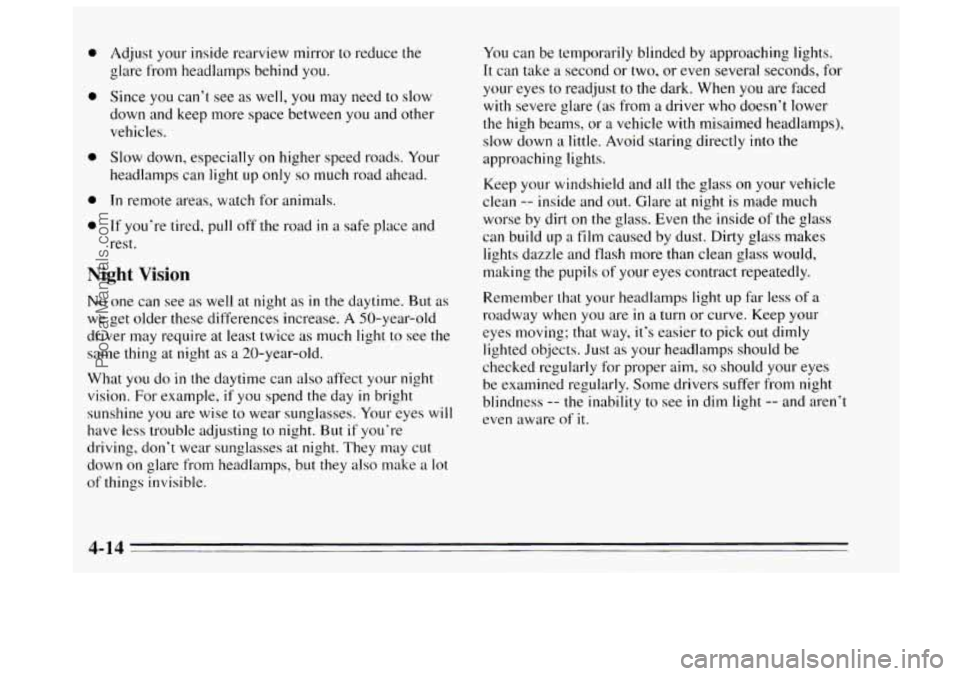
e
0
0
0
0
Adjust your inside rearview mirror to reduce the
glare from headlamps behind you.
Since you can’t see as well, you may need to slow
down and keep more space between you and other
vehicles.
Slow down, especially
on higher speed roads. Your
headlamps can light up
only so much road ahead.
Jn remote areas, watch for animals.
If you‘re tired, pull off the road in a safe place and
rest.
Night Vision
No one can see as well at night as in the daytime. But as
we get older these differences increase. A 50-year-old
driver may require at least twice as much light to see the
same thing at night as a 20-year-old.
What you do
in the daytime can also affect your night
vision. For example,
if you spend the day in bright
sunshine
you are wise to wear sunglasses. Your eyes will
have less trouble adjusting to night. But if you’re
driving, don‘t wear sunglasses at night. They may cut
down
on glare from headlamps, but they also make a lot
of things invisible. You
can be temporarily blinded by approaching lights.
It can take a second or two, or even several seconds, for
your eyes to readjust
to the dark. When you are faced
with severe glare (as from a driver who doesn’t lower
the high beams, or a vehicle with misaimed headlamps),
slow down a little. Avoid staring directly into the
approaching lights.
Keep your windshield and all
the glass on your vehicle
clean
-- inside and out. Glare at night is made much
worse
by dirt on the glass. Even the inside of the glass
can build up a
film caused by dust. Dirty glass makes
lights dazzle and flash more than clean glass would,
making the pupils
of your eyes contract repeatedly.
Remember that
your headlamps light up far less of a
roadway when you are in a turn or curve. Keep your
eyes moving; that way, it’s easier
to pick out dimly
lighted objects. Just as your headlamps should be
checked regularly for proper aim,
so should your eyes
be examined regularly. Some drivers suffer
from night
blindness
-- the inability to see in dim light -- and aren’t
even aware of it.
4-14
ProCarManuals.com
Page 163 of 340
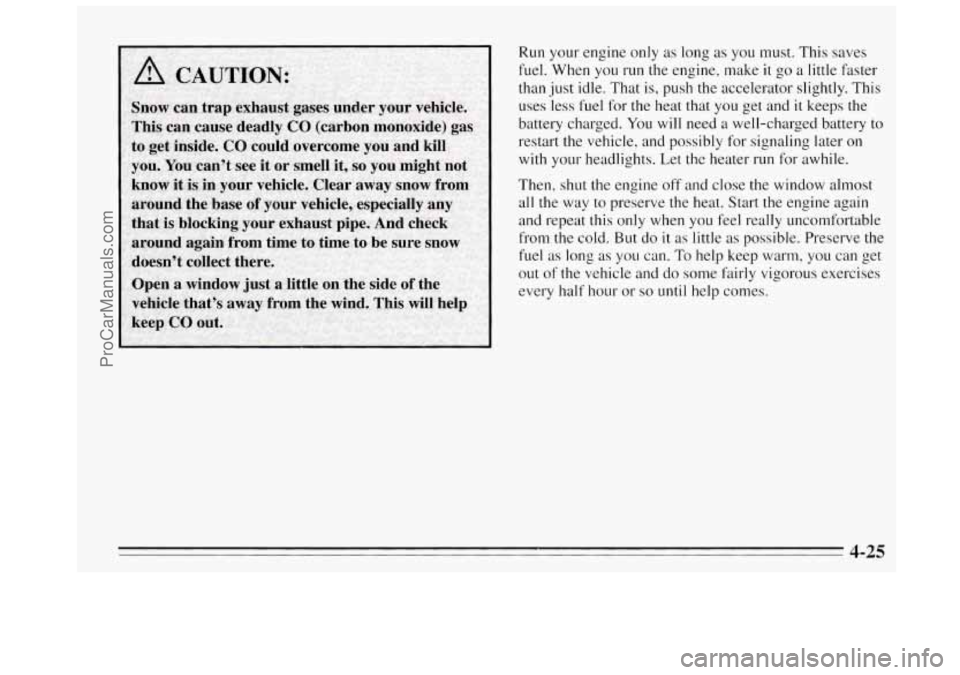
Run your engine only as long as you must. This saves
fuel. When you
run the engine, make it go a little faster
than
just idle. That is, push the accelerator slightly. This
uses ‘less fuel for the heat that you get and it keeps the
battery charged. You will need a well-charged battery to
restart the vehicle, and possibly .for signaling later on
with
your headlights. Let the heater run for awhile.
Then, shut the engine off and close the window almost
all the way to preserve the heat. Start
the engine again
and repeat this only when
you feel really uncomfortable
from the cold.
But do it as little as possible. Preserve the
fuel as long as you can. To help keep warm, you can get
out
of the vehicle and do some fairly vigorous exercises
every half hour or
so until help comes.
4-25
ProCarManuals.com
Page 225 of 340

How to Add Fluid
Refer to the Maintenance Schedule to determine what
kind of transaxle fluid to use. See “Recommended
Fluids and Lubricants”
in the Index.
If the fluid level is low, add only enough of the proper
fluid to bring the level into the cross-hatched area on the
dipstick.
1. Pull out the dipstick.
2. Using a long-neck funnel, add enough fluid at the
dipstick hole
to bring it to the proper level.
It doesn’t take much fluid, generally less than a pint
(OSL). Don ’t ouefill. We recommend you use only fluid
labeled DEXRON@-111, because fluid with that label is
made especially for your automatic transaxle. Damage
caused by fluid other than DEXRON@-I11 is not covered
by your new vehicle warranty.
After adding fluid, recheck the fluid level as
described under “How
to Check.”
When the correct fluid level is obtained, push the
dipstick back in all the way.
Engine Coolant
The following explains your cooling system and how to
add coolant when it is low. If you have a problem with
engine overheating or if
you need to add coolant to your
radiator, see “Engine Overheating” in the Index.
The proper coolant for your Buick will:
Give freezing protection down to -34°F (-37°C).
Give boiling protection up to 262 OF (1 28 O C).
Protect against rust and corrosion.
Help keep the proper engine temperature.
Let the warning lights work as they should.
What to Use
Use a mixture of one-half clean water (preferably
distilled) and one-half antifreeze that meets “GM
Specification
1825-M,” which won’t damage aluminum
parts. You can also use a recycled coolant conforming to
GM Specification 1825-M with a complete coolant flush
and refill. Use GM Engine Coolant Supplement (sealer)
with any complete coolant flush and refill.
If you use
this mixture, you don’t need to add anything else.
~
6-17
ProCarManuals.com
Page 333 of 340
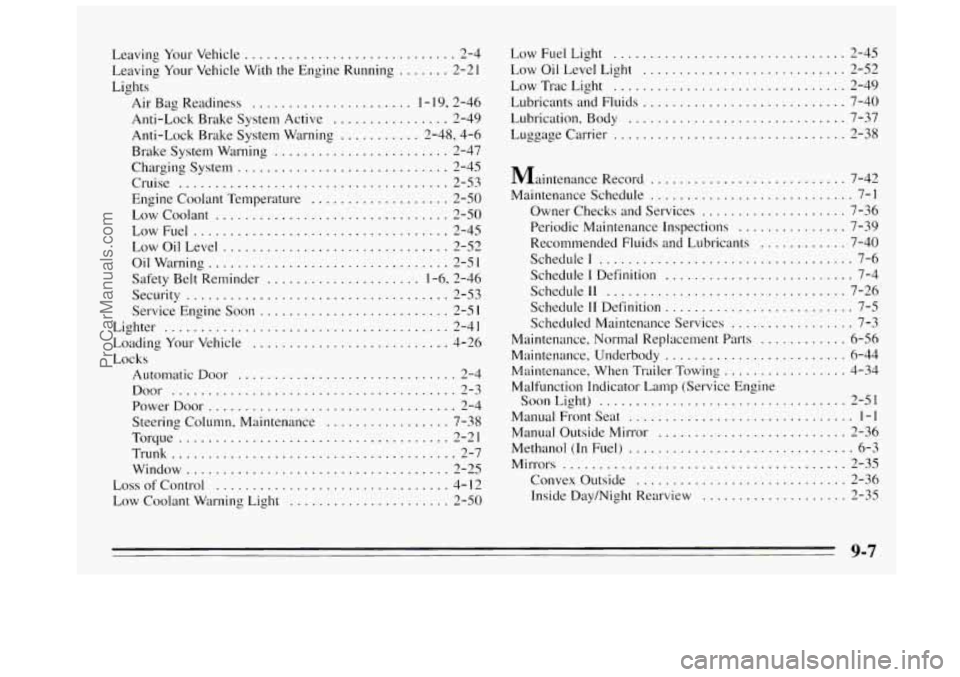
Leaving Your Vehicle ............................. 2-4
Lights Leaving Your Vehicle With the Engine Running
....... 2-21
Air Bag Readiness
...................... 1 . 19. 2.46
Anti-Lock Brake System Active
................ 2-49
Anti-Lock Brake System Warning
........... 2.48. 4.6
Brake System Warning
........................ 2-47
Charging System
............................. 2-45
Cruise
..................................... 2-53
Engine Coolant Temperature
................... 2-50
Low Coolant
................................ 2-50
Low Fuel
................................... 2-45
LowOilLevel
............................... 2-52
Oil Warning
................................. 2-51
Safety Belt Reminder
..................... 1.6. 2.46
Security
.................................... 2-53
Service Engine Soon
.......................... 2-5 1
Lighter ....................................... 2-41
Loading Your Vehicle
........................... 4-26
Locks Automatic Door
.............................. 2-4
PowerDoor
.................................. 2-4
Steering Colulnn. Maintenance
................. 7-38
Torque
..................................... 2-21
Trunk
....................................... 2-7
Window
.................................... 2-25
Loss
of Control ................................ 4- I2
Low Coolant Warning Light ...................... 2-50
Door
....................................... 2-3 LowFuelLight
................................ 2-45
Low Oil Level Light
............................ 2-52
Low Trac Light ................................ 2-49
Lubricants and Fluids
............................ 7-40
Lubrication. Body
.............................. 7-37
Luggage Carrier
................................ 2-38
Maintenance Record
........................... 7-42
Maintenance Schedule
............................ 7-1
Owner Checks and Services
.................... 7-36
Periodic Maintenance Inspections
............... 7-39
Recommended Fluids and Lubricants
............ 7-40
Schedule1
................................... 7-6
Schedule I Definition .......................... 7-4
Schedule11
................................. 7-26
Schedule
I1 Definition .......................... 7-5
Scheduled Maintenance Services ................. 7-3
Maintenance, Normal Replacement Parts
............ 6-56
Maintenance, Underbody
......................... 6-44
Maintenance,
When Trailer Towing ................. 4-34
Malfunction Indicator Lamp (Service Engine
Soon Light) .................................. 2-51
Manual Front Seat
............................... 1-1
Manual Outside Mirror .......................... 2-36
Methanol
(In Fuel) ............................... 6-3
Mirrors
....................................... 2-35
Convex Outside
............................. 2-36
Inside Day/Night Rearview
.................... 2-35
9-7
ProCarManuals.com